This article has been reviewed according to Science X's editorial process and policies. Editors have highlighted the following attributes while ensuring the content's credibility:
fact-checked
trusted source
proofread
NASA's Webb depicts staggering structure in 19 nearby spiral galaxies
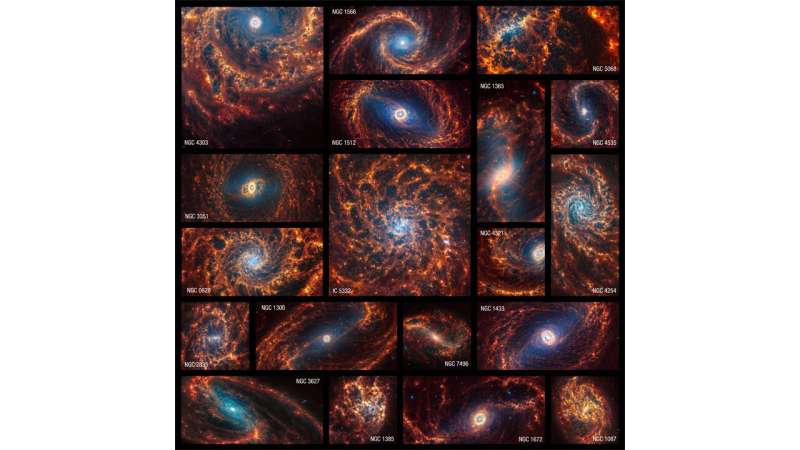
A new treasure trove of Webb images has arrived. Near- and mid-infrared images show off every facet of these face-on spiral galaxies.
Humanity has spent centuries mapping Earth's features—and we frequently repeat the process by using more advanced instruments. When we combine the data, we get a more complete understanding of our planet.
Now, look outward into space. Astronomers have observed nearby, face-on spiral galaxies for decades. Both space- and ground-based telescopes have contributed to a cache of data in wavelengths from radio to ultraviolet light. Astronomers have long planned to use NASA's James Webb Space Telescope to obtain the highest resolution near- and mid-infrared images ever taken of these galaxies, and today they are publicly available.
Everyone can explore Webb's newest set of exquisite images, which show stars, gas, and dust on small scales beyond our own galaxy. Teams of researchers are studying these images to uncover the origins of these intricate structures. The research community's collective analysis will ultimately inform theorists' simulations, and advance our understanding of star formation and the evolution of spiral galaxies.
It's oh-so-easy to be absolutely mesmerized by these spiral galaxies. Follow their clearly defined arms, which are brimming with stars, to their centers, where there may be old star clusters and—sometimes—active supermassive black holes. Only NASA's James Webb Space Telescope can deliver highly detailed scenes of nearby galaxies in a combination of near- and mid-infrared light.
-
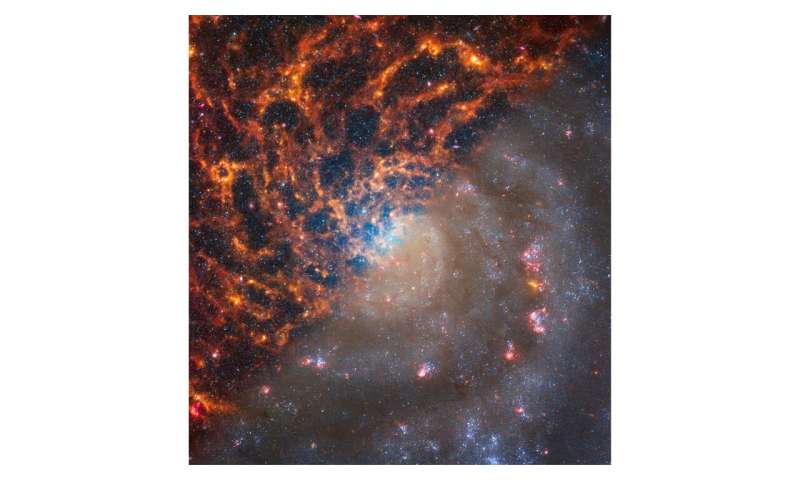
Webb and Hubble’s views of Spiral Galaxy IC 5332. Credit: Space Telescope Science Institute -
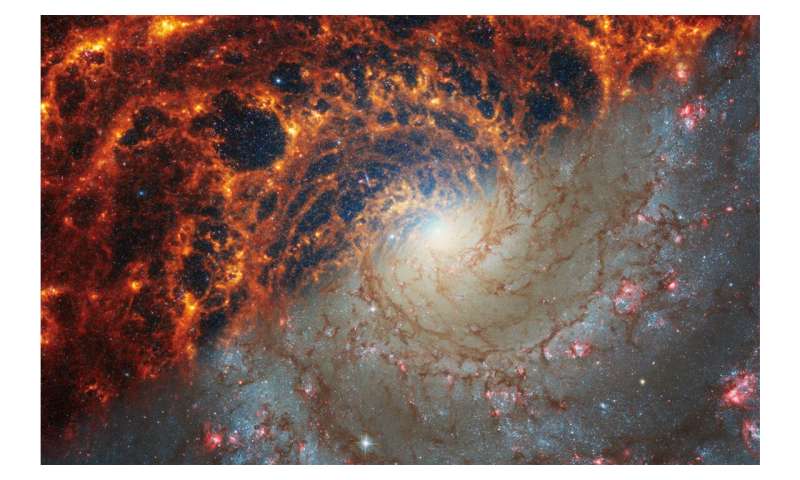
Webb and Hubble’s views of Spiral Galaxy NGC 628. Credit: Space Telescope Science Institute
These Webb images are part of a large, long-standing project, the Physics at High Angular resolution in Nearby GalaxieS (PHANGS) program, which is supported by more than 150 astronomers worldwide. Before Webb took these images, PHANGS was already brimming with data from NASA's Hubble Space Telescope, the Very Large Telescope's Multi-Unit Spectroscopic Explorer, and the Atacama Large Millimeter/submillimeter Array, including observations in ultraviolet, visible, and radio light. Webb's near- and mid-infrared contributions have provided several new puzzle pieces.
]"Webb's new images are extraordinary," said Janice Lee, a project scientist for strategic initiatives at the Space Telescope Science Institute in Baltimore. "They're mind-blowing even for researchers who have studied these same galaxies for decades. Bubbles and filaments are resolved down to the smallest scales ever observed, and tell a story about the star formation cycle."
Excitement rapidly spread throughout the team as the Webb images flooded in. "I feel like our team lives in a constant state of being overwhelmed—in a positive way—by the amount of detail in these images," added Thomas Williams, a postdoctoral researcher at the University of Oxford in the United Kingdom.
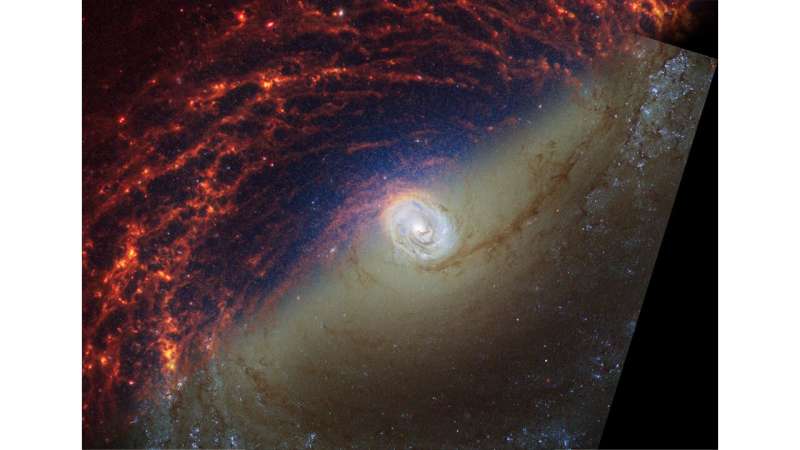
Follow the spiral arms
Webb's NIRCam (Near-Infrared Camera) captured millions of stars in these images, which sparkle in blue tones. Some stars are spread throughout the spiral arms, but others are clumped tightly together in star clusters.
The telescope's MIRI (Mid-Infrared Instrument) data highlights glowing dust, showing us where it exists around and between stars. It also spotlights stars that haven't yet fully formed—they are still encased in the gas and dust that feed their growth, like bright red seeds at the tips of dusty peaks. "These are where we can find the newest, most massive stars in the galaxies," said Erik Rosolowsky, a professor of physics at the University of Alberta in Edmonton, Canada.
Something else that amazed astronomers? Webb's images show large, spherical shells in the gas and dust. "These holes may have been created by one or more stars that exploded, carving out giant holes in the interstellar material," explained Adam Leroy, a professor of astronomy at the Ohio State University in Columbus.
Now, trace the spiral arms to find extended regions of gas that appear red and orange. "These structures tend to follow the same pattern in certain parts of the galaxies," Rosolowsky added. "We think of these like waves, and their spacing tells us a lot about how a galaxy distributes its gas and dust." Study of these structures will provide key insights about how galaxies build, maintain, and shut off star formation.
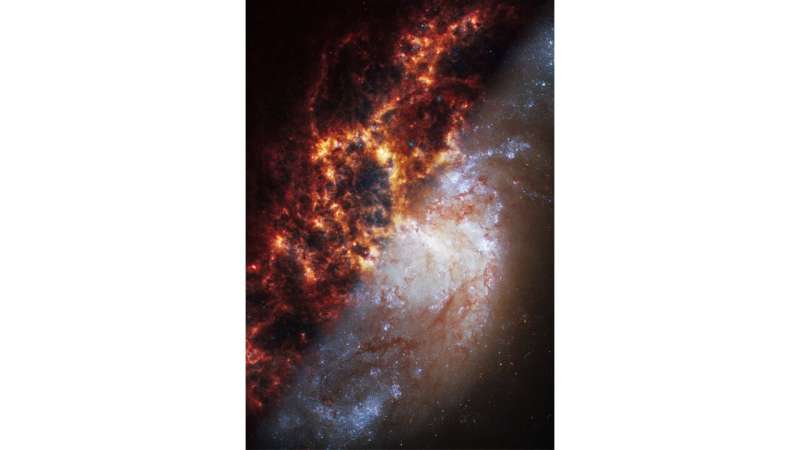
Dive into the interior
Evidence shows that galaxies grow from inside out—star formation begins at galaxies' cores and spreads along their arms, spiraling away from the center. The farther a star is from the galaxy's core, the more likely it is to be younger. In contrast, the areas near the cores that look lit by a blue spotlight are populations of older stars.
What about galaxy cores that are awash in pink-and-red diffraction spikes? "That's a clear sign that there may be an active supermassive black hole," said Eva Schinnerer, a staff scientist at the Max Planck Institute for Astronomy in Heidelberg, Germany. "Or, the star clusters toward the center are so bright that they have saturated that area of the image."
Research galore
There are many avenues of research that scientists can begin to pursue with the combined PHANGS data, but the unprecedented number of stars Webb resolved are a great place to begin. "Stars can live for billions or trillions of years," Leroy said. "By precisely cataloging all types of stars, we can build a more reliable, holistic view of their life cycles."
In addition to immediately releasing these images, the PHANGS team has also released the largest catalog to date of roughly 100,000 star clusters. "The amount of analysis that can be done with these images is vastly larger than anything our team could possibly handle," Rosolowsky emphasized. "We're excited to support the community so all researchers can contribute."
More information: More images are available here.
Provided by Space Telescope Science Institute





















